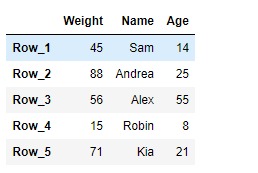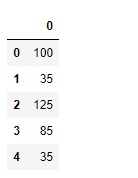Pandas DataFrame是带有标签轴(行和列)的二维大小可变的,可能是异构的表格数据结构。算术运算在行和列标签上对齐。可以将其视为Series对象的dict-like容器。这是 Pandas 的主要数据结构。
Pandas DataFrame.ftypes属性返回DataFrame中的ftypes(指示稀疏/密集和dtype)。它返回具有每个列的数据类型的Series。
用法: DataFrame.ftypes
参数:没有
返回:系列
范例1:采用DataFrame.ftypes属性以检查给定Dataframe中的列是否稀疏或密集。
# importing pandas as pd
import pandas as pd
# Creating the DataFrame
df = pd.DataFrame({'Weight':[45, 88, 56, 15, 71],
'Name':['Sam', 'Andrea', 'Alex', 'Robin', 'Kia'],
'Age':[14, 25, 55, 8, 21]})
# Create the index
index_ = ['Row_1', 'Row_2', 'Row_3', 'Row_4', 'Row_5']
# Set the index
df.index = index_
# Print the DataFrame
print(df)输出:

现在我们将使用DataFrame.ftypes属性以检查给定数据帧中列的ftype。
# check if the column are
# dense or sparse
result = df.ftypes
# Print the result
print(result)输出:

正如我们在输出中看到的,DataFrame.ftypes属性已成功返回包含给定数据帧中每一列的ftypes的系列。
范例2:采用DataFrame.ftypes属性以检查给定Dataframe中的列是否稀疏或密集。
# importing pandas as pd
import pandas as pd
# Create an array
arr = [100, 35, 125, 85, 35]
# Creating a sparse DataFrame
df = pd.SparseDataFrame(arr)
# Print the DataFrame
print(df)输出:

现在我们将使用DataFrame.ftypes属性以检查给定数据帧中列的ftype。
# check if the column are
# dense or sparse
result = df.ftypes
# Print the result
print(result)输出:

正如我们在输出中看到的,DataFrame.ftypes属性已成功返回给定数据帧的ftype。
相关用法
- Python pandas.map()用法及代码示例
- Python Pandas Series.str.len()用法及代码示例
- Python Pandas.factorize()用法及代码示例
- Python Pandas TimedeltaIndex.name用法及代码示例
- Python Pandas dataframe.ne()用法及代码示例
- Python Pandas Series.between()用法及代码示例
- Python Pandas DataFrame.where()用法及代码示例
- Python Pandas Series.add()用法及代码示例
- Python Pandas.pivot_table()用法及代码示例
- Python Pandas Series.mod()用法及代码示例
- Python Pandas Dataframe.at[ ]用法及代码示例
- Python Pandas Dataframe.iat[ ]用法及代码示例
- Python Pandas.pivot()用法及代码示例
- Python Pandas dataframe.mul()用法及代码示例
- Python Pandas.melt()用法及代码示例
注:本文由纯净天空筛选整理自Shubham__Ranjan大神的英文原创作品 Python | Pandas DataFrame.ftypes。非经特殊声明,原始代码版权归原作者所有,本译文未经允许或授权,请勿转载或复制。
